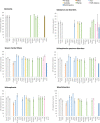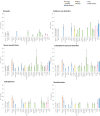Life expectancy and years of potential life lost in people with mental disorders: a systematic review and meta-analysis
- PMID: 37965432
- PMCID: PMC10641487
- DOI: 10.1016/j.eclinm.2023.102294
Life expectancy and years of potential life lost in people with mental disorders: a systematic review and meta-analysis
Abstract
Background: Mental disorders are associated with premature mortality. There is increasing research examining life expectancy and years-of-potential-life-lost (YPLL) to quantify the disease impact on survival in people with mental disorders. We aimed to systematically synthesize studies to estimate life expectancy and YPLL in people with any and specific mental disorders across a broad spectrum of diagnoses.
Methods: In this systematic review and meta-analysis, we searched Embase, MEDLINE, PsychINFO, WOS from inception to July 31, 2023, for published studies reporting life expectancy and/or YPLL for mental disorders. Criteria for study inclusion were: patients of all ages with any mental disorders; reported data on life expectancy and/or YPLL of a mental-disorder cohort relative to the general population or a comparison group without mental disorders; and cohort studies. We excluded non-cohort studies, publications containing non-peer-reviewed data or those restricted to population subgroups. Survival estimates, i.e., life expectancy and YPLL, were pooled (based on summary data extracted from the included studies) using random-effects models. Subgroup analyses and random-effects meta-regression analyses were performed to explore sources of heterogeneity. Risk-of-bias assessment was evaluated using the Newcastle-Ottawa Scale. This study is registered with PROSPERO (CRD42022321190).
Findings: Of 35,865 studies identified in our research, 109 studies from 24 countries or regions including 12,171,909 patients with mental disorders were eligible for analysis (54 for life expectancy and 109 for YPLL). Pooled life expectancy for mental disorders was 63.85 years (95% CI 62.63-65.06; I2 = 100.0%), and pooled YPLL was 14.66 years (95% CI 13.88-15.98; I2 = 100.0%). Disorder-stratified analyses revealed that substance-use disorders had the shortest life expectancy (57.07 years [95% CI 54.47-59.67]), while neurotic disorders had the longest lifespan (69.51 years [95% CI 67.26-71.76]). Substance-use disorders exhibited the greatest YPLL (20.38 years [95% CI 18.65-22.11]), followed by eating disorders (16.64 years [95% CI 7.45-25.82]), schizophrenia-spectrum disorders (15.37 years [95% CI 14.18-16.55]), and personality disorders (15.35 years [95% CI 12.80-17.89]). YPLLs attributable to natural and unnatural deaths in mental disorders were 4.38 years (95% CI 3.15-5.61) and 8.11 years (95% CI 6.10-10.13; suicide: 8.31 years [95% CI 6.43-10.19]), respectively. Stratified analyses by study period suggested that the longevity gap persisted over time. Significant cross-study heterogeneity was observed.
Interpretation: Mental disorders are associated with substantially reduced life expectancy, which is transdiagnostic in nature, encompassing a wide range of diagnoses. Implementation of comprehensive and multilevel intervention approaches is urgently needed to rectify lifespan inequalities for people with mental disorders.
Funding: None.
Keywords: Life expectancy; Mental illness; Meta-analysis; Premature mortality; YPLL; Years of potential life lost.
© 2023 The Author(s).
Conflict of interest statement
CUC has been a consultant and/or advisor to or has received honoraria from: AbbVie, Acadia, Alkermes, Allergan, Angelini, Aristo, Biogen, Boehringer-Ingelheim, Cardio Diagnostics, Cerevel, CNX Therapeutics, Compass Pathways, Darnitsa, Denovo, Gedeon Richter, Hikma, Holmusk, IntraCellular Therapies, Janssen/J&J, Karuna, LB Pharma, Lundbeck, MedAvante-ProPhase, MedInCell, Merck, Mindpax, Mitsubishi Tanabe Pharma, Mylan, Neurocrine, Neurelis, Newron, Noven, Novo Nordisk, Otsuka, Pharmabrain, PPD Biotech, Recordati, Relmada, Reviva, Rovi, Seqirus, SK Life Science, Sunovion, Sun Pharma, Supernus, Takeda, Teva, and Viatris. He provided expert testimony for Janssen and Otsuka. He served on a Data Safety Monitoring Board for Compass Pathways, Denovo, Lundbeck, Relmada, Reviva, Rovi, Sage, Supernus, Tolmar, and Teva. He has received grant support from Janssen and Takeda. He received royalties from UpToDate and is also a stock option holder of Cardio Diagnostics, Mindpax, LB Pharma, PsiloSterics, and Quantic. All other authors declare no competing interests.
Figures







References
-
- Vigo D., Thornicroft G., Atun R. Estimating the true global burden of mental illness. Lancet Psychiatry. 2016;3(2):171–178. - PubMed
-
- Plana-Ripoll O., Pedersen C.B., Agerbo E., et al. A comprehensive analysis of mortality-related health metrics associated with mental disorders: a nationwide, register-based cohort study. Lancet. 2019;394(10211):1827–1835. - PubMed
LinkOut - more resources
Full Text Sources
Miscellaneous

